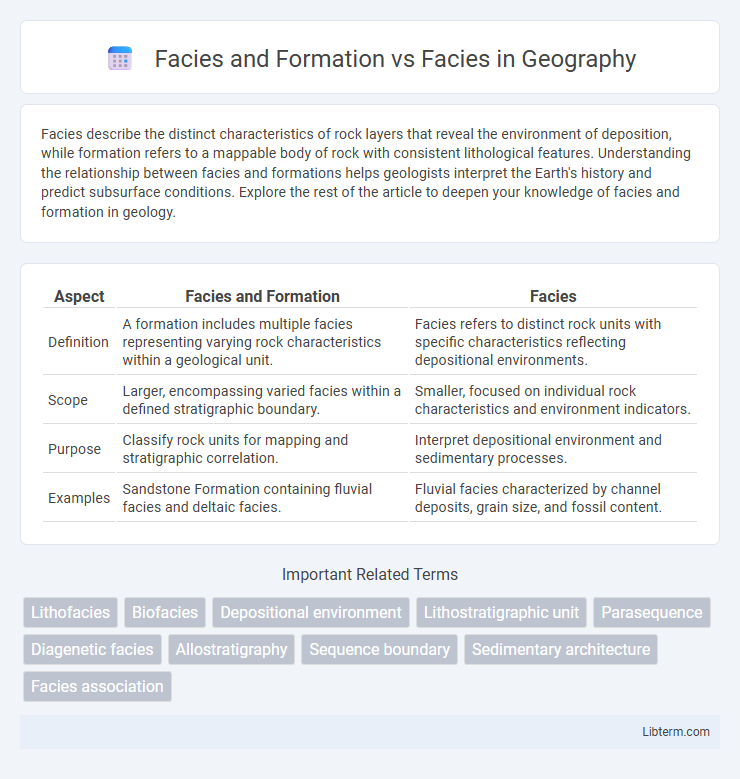Facies describe the distinct characteristics of rock layers that reveal the environment of deposition, while formation refers to a mappable body of rock with consistent lithological features. Understanding the relationship between facies and formations helps geologists interpret the Earth's history and predict subsurface conditions. Explore the rest of the article to deepen your knowledge of facies and formation in geology.
Table of Comparison
| Aspect | Facies and Formation | Facies |
|---|---|---|
| Definition | A formation includes multiple facies representing varying rock characteristics within a geological unit. | Facies refers to distinct rock units with specific characteristics reflecting depositional environments. |
| Scope | Larger, encompassing varied facies within a defined stratigraphic boundary. | Smaller, focused on individual rock characteristics and environment indicators. |
| Purpose | Classify rock units for mapping and stratigraphic correlation. | Interpret depositional environment and sedimentary processes. |
| Examples | Sandstone Formation containing fluvial facies and deltaic facies. | Fluvial facies characterized by channel deposits, grain size, and fossil content. |
Introduction to Facies: Definition and Importance
Facies represent distinct rock units characterized by specific physical, chemical, and biological attributes that reflect depositional environments. Understanding Facies is crucial for interpreting sedimentary processes, paleoenvironmental conditions, and reservoir quality. Formation vs Facies terminology distinguishes the broader stratigraphic unit (Formation) from the specific depositional characteristics (Facies) within that unit.
Geological Formations: An Overview
Geological formations represent large-scale rock units with distinct lithological characteristics recognized in stratigraphy, while facies refer to specific rock attributes within those formations that reflect particular depositional environments or conditions. Facies analysis provides detailed insight into sedimentary processes and paleoenvironments by examining variations in texture, composition, and fossil content, allowing geologists to interpret the spatial and temporal distribution of sediments within a formation. Understanding the relationship between formations and facies is essential for reconstructing geological history, resource exploration, and basin analysis.
Facies vs. Formation: Key Differences
Facies represent distinctive rock units characterized by specific lithological, biological, and sedimentary features, reflecting particular depositional environments, whereas formations are formal stratigraphic units used to map and describe rock layers with consistent lithology and stratigraphic position. The key difference lies in facies emphasizing environmental interpretation and variability within formations, while formations serve as broader, mappable units essential for geological mapping and correlation. Understanding facies versus formations is critical for reconstructing paleoenvironmental conditions and for practical applications in stratigraphy and resource exploration.
The Role of Facies in Stratigraphy
Facies in stratigraphy represent distinct rock units characterized by specific sedimentary, mineralogical, and fossil attributes reflecting depositional environments, enabling detailed paleoenvironmental interpretation. Formation refers to a formal lithostratigraphic unit defined by consistent lithology and stratigraphic position, frequently encompassing multiple facies variations within its boundaries. Understanding facies within formations allows geologists to correlate depositional environments across regions and reconstruct stratigraphic sequences with higher resolution, essential for basin analysis and resource exploration.
Facies and Formation: Interrelationships
Facies and formation are integral concepts in stratigraphy, where facies represent distinct rock units characterized by specific sedimentary, paleontological, and chemical attributes within a formation. The formation encompasses a collection of facies formed under varying depositional environments, reflecting spatial and temporal changes in sedimentation processes. Understanding the interrelationships between facies and formation enables geologists to reconstruct paleoenvironments and interpret sedimentary basin evolution with greater accuracy.
Types of Facies in Geological Contexts
Facies in geological contexts refer to distinct rock units characterized by specific physical, chemical, and biological features that reflect particular depositional environments. Types of facies include lithofacies, defined by rock type and texture, and biofacies, distinguished by fossil content, while formation facies represent mappable rock bodies sharing similar characteristics within a geological formation. Understanding these facies types is crucial for interpreting sedimentary environments, stratigraphic correlations, and basin evolution in petroleum geology and sedimentology.
Formation Boundaries and Facies Variations
Formation boundaries represent distinct lithological changes marking the limits of depositional units, while facies variations within these formations reflect changes in sedimentary environments and processes. Facies analysis emphasizes lateral and vertical shifts in rock characteristics, revealing depositional settings, whereas formation boundaries provide a stratigraphic framework for these variations. Understanding the interplay of facies changes across formation boundaries aids in reconstructing basin evolution and sediment dispersal patterns.
Sedimentary Facies: Case Studies
Sedimentary facies represent distinct bodies of sediment with specific characteristics reflecting unique depositional environments, critical for interpreting past geological conditions. In contrast, formations are formal lithostratigraphic units defined by consistent rock types and stratigraphic position, often comprising multiple facies. Case studies in sedimentary facies analysis reveal variations in grain size, mineral composition, and fossil content that help reconstruct paleoenvironments and sequence stratigraphy within formations.
Facies Models and Geological Mapping
Facies models provide a detailed representation of sedimentary environments by integrating lithological, paleontological, and sedimentological data to interpret depositional processes and paleoenvironmental conditions. Geological mapping uses facies distribution and spatial relationships to delineate formation boundaries and reconstruct basin architecture, facilitating resource exploration and stratigraphic correlation. Understanding the distinction between facies as local sediment characteristics and formations as formal stratigraphic units enhances the precision of geological interpretations and predictive modeling.
Implications for Hydrocarbon Exploration and Reservoir Analysis
Facies and Formation concepts are critical in hydrocarbon exploration and reservoir analysis, as facies represent the specific depositional environments and rock characteristics within a formation that control reservoir quality and heterogeneity. While formations define the stratigraphic units, facies variations within these formations influence porosity, permeability, and fluid distribution, directly impacting reservoir characterization and development strategies. Understanding facies distribution improves prediction of reservoir extent and compartmentalization, aiding in more accurate resource estimation and optimized well placement.
Facies and Formation Infographic

 libterm.com
libterm.com